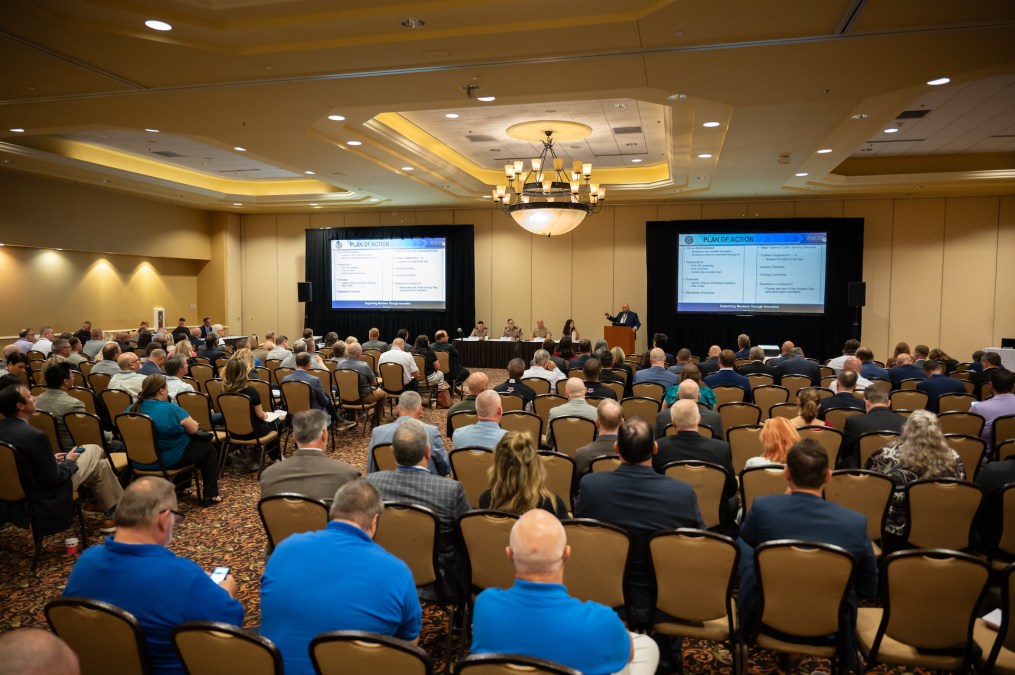Industry spotlights tech gaps as DOD puzzles out new PCS plan for moving military families

The Pentagon’s new Permanent Change of Station Joint Task Force hosted an industry day this week with movers, shippers and capability providers of many types and sizes, where they discussed new ideas to help transform the Defense Department’s system for moving military families’ personal belongings when they’re relocated around the world for new orders or other purposes.
According to a 20-page summary brief that a task force official shared with DefenseScoop on Friday, opportunities for technologies to make the complex moving process smoother for service members and industry players marked a key theme spotlighted throughout that event.
“We need your expertise in logistics, supply chain management, customer service and technology to revolutionize the way we handle household goods moves,” Army Maj. Gen. Lance Curtis, the PCS JTF commander, told the more than 200 stakeholders in attendance.
The industry day near Scott Air Force Base, Illinois, took place against a backdrop of major disruptions and uncertainty within the DOD’s household goods moving program.
Military families have increasingly sounded the alarm in recent years about negative experiences with a PCS system that was largely plagued with widespread delays, bad communication, and lost and damaged goods — that ultimately resulted in a large-scale collapse in trust in the government’s process. This summer, Defense Secretary Pete Hegseth terminated DOD’s multibillion-dollar Global Household Goods contract with the prime contractor HomeSafe Alliance, and set up the joint task force to determine the future of the program.
In the summary brief, the defense official noted that this week’s industry day-led feedback sessions delivered “critical input to that process.”
The agenda included moderated discussions with government and commercial representatives, and multiple open-mic question and answer opportunities. The moving and logistics professionals who attended represented a wide spectrum of the overarching industry, including large van lines, independent moving agents, industry associations, international specialists, third-party service providers, technology companies and more.
“Many speakers identified themselves as small business owners, local agents, and veterans, providing a ‘boots on the ground’ perspective on the daily operational realities and challenges of executing military moves,” the summary states. “The tone was professional but candid, and at times, passionate and frustrated.”
In one on-stage panel, “key topics included the hindrances to innovation caused by restrictive government regulations and program uncertainty, the economic strain on moving agents, the desire for a more collaborative partnership with the government, and specific technological solutions like electronic inventories, shipment tracking, and data integration via [Application Programming Interfaces or] APIs,” per the summary document.
That latter conversation on data and APIs eventually shifted from officials simply advocating for specific technologies — like a mobile app — to a more complex discussion about using APIs to allow diverse industry systems to communicate with a central government platform that could present a flexible and modern approach to information-sharing.
Regarding cloud connectivity and more advanced software analyses capabilities to enable the future post-reform process, the summary notes that “the introduction of ideas from Amazon Web Services about leveraging cloud data lakes and predictive analytics represented a forward-looking trend, suggesting the use of data to predict issues like delays before they happen.”
An AWS spokesperson did not immediately respond to a request from DefenseScoop to provide more information about the company’s contributions to the industry day this week.
During other sessions, industry participants further highlighted how the economic uncertainty sparked by the department’s recent actions to reshape the contract and approach had put the industry in “survival mode” — to a point where they were preventing necessary investments in equipment, technology and people.
“The ‘GHC hangover’ was mentioned multiple times, with its failure serving as the primary evidence against future single-source or radical overhaul attempts,” the summary noted, using an acronym to refer to Global Household Goods.
Some attendees also suggested that the government’s regulatory framework was the primary obstacle to innovation and service improvement, as opposed to any lack of industry capability.
They shed light on how the moving industry has been slow to apply new technologies to military moves, citing those restrictive regulations as the top barrier. Real-world examples of how the government’s existing rules hindered innovation in this space were provided, and questions about the impact of technology mandates on small carriers also spurred engagements on pursuing incentivization instead of mandates.
Beyond technology, some of the other recurring themes brought up at the event and referenced in the summary include the need for DOD to expand outreach with industry players; supply improved performance metrics that are statistically valid, fair and properly reflective; work to better understand the urgent financial pressure on industry due to instability in the current process; and establish a competitive and adaptable environment to ensure future success and resilience.
“Multiple speakers emphasized that technology alone could not solve core service issues. They stressed the importance of supporting the agents and crews at the curb, who are the face of the program to the service member,” the document noted.
Industry participants who want to provide further input to inform this DOD modernization effort are invited to submit up to five pages of recommendations to a newly created government email inbox, by Aug. 18.
“Ultimately, the feedback provided could directly shape the options presented to the Secretary of Defense” in September, the industry summary viewed by DefenseScoop states.




